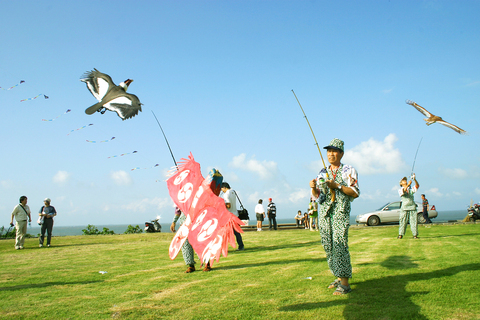Every year around this time the northernmost town of Taiwan, Shihmen (石門) has played host to kite-flying enthusiasts with the International Kite Festival.
Taipei County Government has been behind the event since 2000 and this year there are also many sponsors from the business community.
Although kite-flying is a traditional leisure sport in Taiwan, the festival has an international outlook, with Japanese, South Korean and Western techniques of kite making and flying on show.

PHOTO COURTESY OF TAIPEI COUNTY GOVERNMENT
A series of kite-flying events have been scheduled for every weekend of this month and the first weekend of October. The festival officially begins with a kite collection exhibition from Sept. 10 at the county government's administration building in Banciao (板橋), on the first floor.
There will be kite color drawing and stunt kite show at the Zhonghe (中和) Number Four park on Sept. 18, beginning 10am. On Sept. 24 and Sept. 25 there will be a display of different kinds of kites, including fighter kites, giant kites, stunt kites, surfing kites, buggy kites, jet balloons and air yoyos, at Green Bay in Wanli (萬里鄉翡翠灣). Uniquely, a night kite flying activity will be held there from 8pm on Saturday. On Sunday, rokaru fight kites will be on show between 4pm and 4:30pm.
In the first weekend of October, similar activities will be demonstrated at Baisha Bay (白沙灣) in Shihmen, but without the night kite flying and rokaru fight events. There will, however, be kite-making workshops and cultural seminars at the site.
International kite making experts and fliers will be invited to participate, in addition to kite-flying pros from Taiwan, such as Buteo Huang (黃景楨), and other high-profile professionals from the US, Canada, France, Germany, UK, Holland, Austria, India, Singapore, Malaysia, Australia, Japan and South Korea.

The canonical shot of an East Asian city is a night skyline studded with towering apartment and office buildings, bright with neon and plastic signage, a landscape of energy and modernity. Another classic image is the same city seen from above, in which identical apartment towers march across the city, spilling out over nearby geography, like stylized soldiers colonizing new territory in a board game. Densely populated dynamic conurbations of money, technological innovation and convenience, it is hard to see the cities of East Asia as what they truly are: necropolises. Why is this? The East Asian development model, with

June 16 to June 22 The following flyer appeared on the streets of Hsinchu on June 12, 1895: “Taipei has already fallen to the Japanese barbarians, who have brought great misery to our land and people. We heard that the Japanese occupiers will tax our gardens, our houses, our bodies, and even our chickens, dogs, cows and pigs. They wear their hair wild, carve their teeth, tattoo their foreheads, wear strange clothes and speak a strange language. How can we be ruled by such people?” Posted by civilian militia leader Wu Tang-hsing (吳湯興), it was a call to arms to retake

This is a deeply unsettling period in Taiwan. Uncertainties are everywhere while everyone waits for a small army of other shoes to drop on nearly every front. During challenging times, interesting political changes can happen, yet all three major political parties are beset with scandals, strife and self-inflicted wounds. As the ruling party, the Democratic Progressive Party (DPP) is held accountable for not only the challenges to the party, but also the nation. Taiwan is geopolitically and economically under threat. Domestically, the administration is under siege by the opposition-controlled legislature and growing discontent with what opponents characterize as arrogant, autocratic

When Lisa, 20, laces into her ultra-high heels for her shift at a strip club in Ukraine’s Kharkiv, she knows that aside from dancing, she will have to comfort traumatized soldiers. Since Russia’s 2022 invasion, exhausted troops are the main clientele of the Flash Dancers club in the center of the northeastern city, just 20 kilometers from Russian forces. For some customers, it provides an “escape” from the war, said Valerya Zavatska — a 25-year-old law graduate who runs the club with her mother, an ex-dancer. But many are not there just for the show. They “want to talk about what hurts,” she